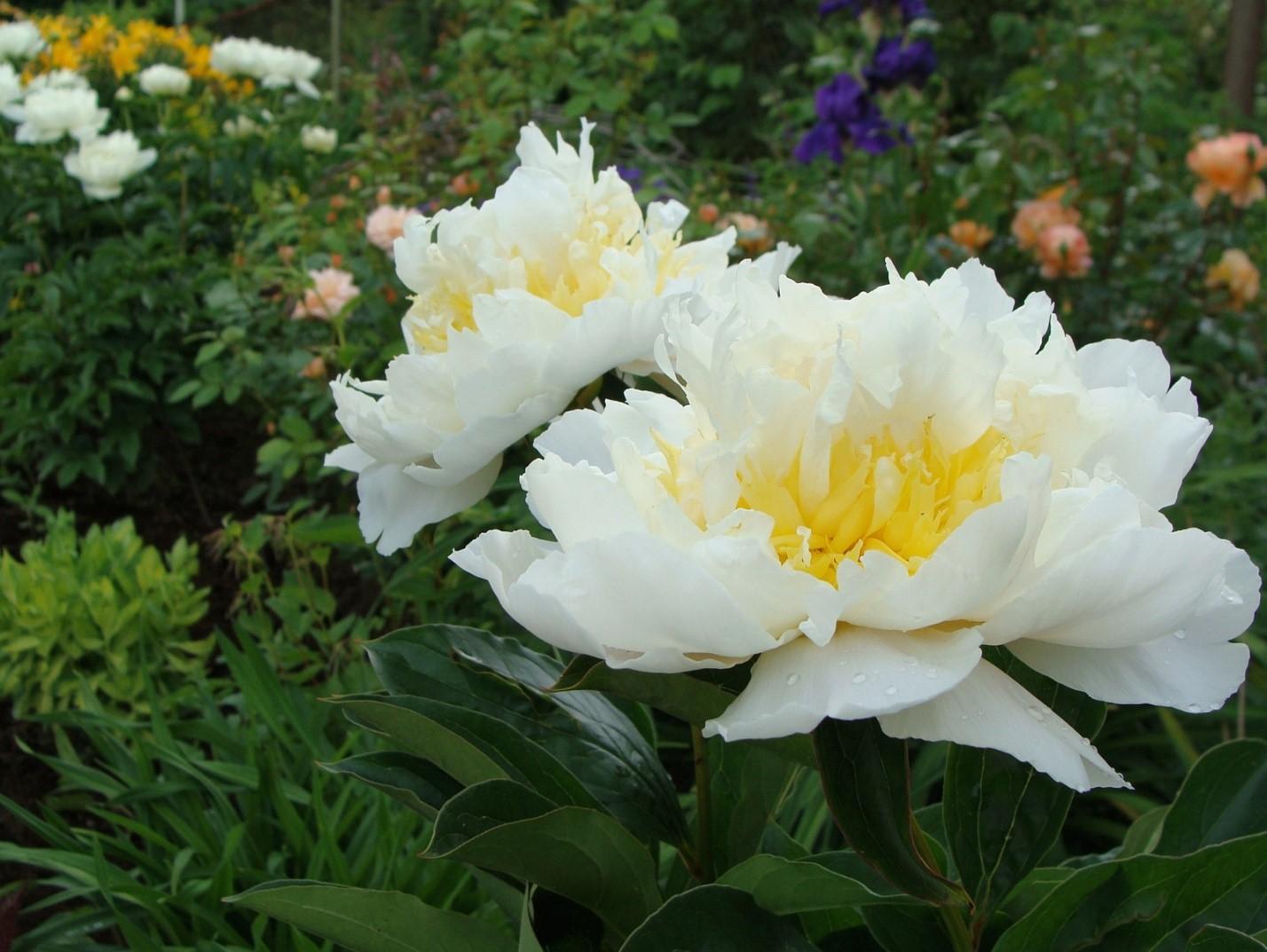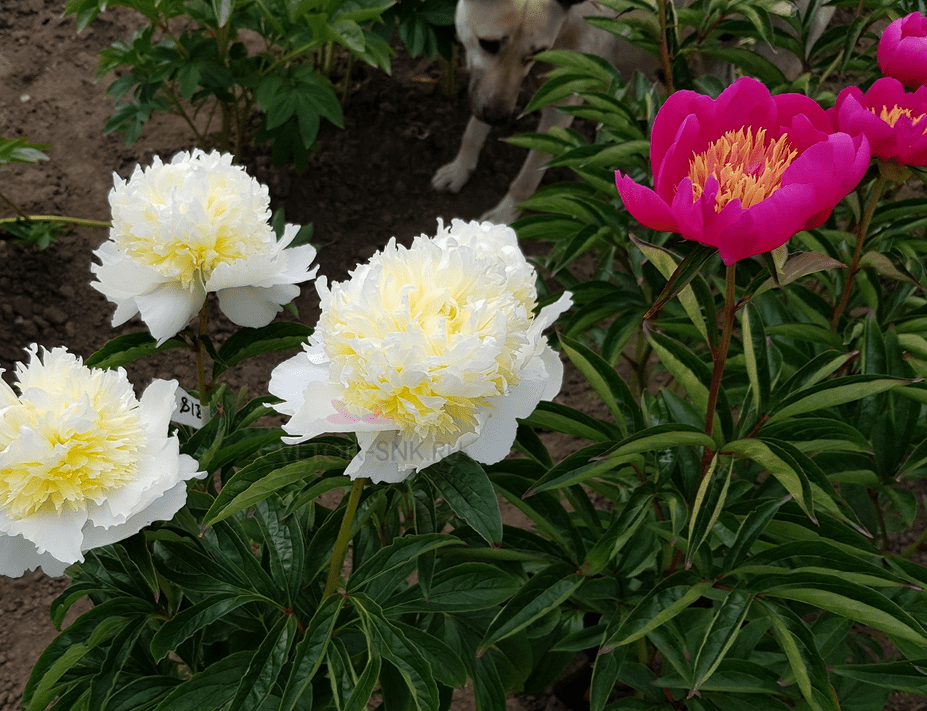Content
Peony Honey Gold is one of the most original flowers with a white and yellow color. It blooms from late May to mid-June, the inflorescences are quite large. They last a long time when cut, so they are suitable for making bouquets. The rules for growing this shrub are simple - they are described in detail in the presented material.
History of appearance
There is no exact data on the selection of the Honey Gold variety. However, it is known that it belongs to the group of milky-flowered peonies. They all descended from a common ancestor that is still found in nature. Moreover, the wild variety has pure white, milky petals, which is what the name of the species is associated with.
Many other varieties with more varied colors have been obtained from milkflowers, including yellow-white, as is the case with Honey Gold. Translated from English, Honey Gold, the name of this variety means “golden honey.”
Description of the milky peony Honey Gold with photo
The Honey Gold variety is a perennial shrub with peduncles of average height from 80 to 100 cm. The stems are quite strong and well leafed.The plates are dark green, narrow in shape, creating a beautiful background.
The flowers of the Honey Gold peony are quite large, reaching 15 cm in diameter. The color is very interesting, white and pink, and the core is bright yellow, really reminiscent of flower honey. The petals are gracefully shaped, the surface is highly corrugated.

Flowers appear in the first half of June
Honey Gold peony inflorescences give a pleasant aroma and last a long time when cut. Therefore, they can be used not only to decorate the site, but also to make bouquets.
This allows you to grow the crop not only in the middle zone, but also in Siberia and the northern regions.
In the center of the Honey Gold peony inflorescence, several petals can be connected. Thanks to this, a kind of twisted crest is formed, which looks very original.
Timing and duration of flowering
Peony Honey Gold blooms from late May to mid-June. Flowering duration is usually 2-3 weeks. Buds are formed in large quantities, but a lot depends on care, weather and especially the presence of sunlight. If the spring was cold, flowering may begin 7-10 days later.
Advantages and disadvantages
Peony Honey Gold has not only an original color, but also an interesting flower shape. It consists of numerous petals growing in rows. Moreover, the inner ones are small and often curl into a tuft, while the outer ones are larger and have a delicate white color with a hint of pink. Thanks to this, even medium-sized inflorescences look voluminous and quite lush.

Flowers have an interesting shape and double color
Pros:
- flowers of original shade;
- fancy look with a tuft;
- pleasant aroma;
- stand for a long time when cut;
- the bush withstands frosts well;
- undemanding to care;
- peduncles are strong and do not require support;
- The bush is compact and does not take up much space.
Minuses:
- possible infection with infectious diseases;
- the inflorescences are not the largest.
Landing scheme and rules
Since the Honey Gold peony bush does not spread, it can be planted even in a small flower bed. When creating a composition, seedlings are placed in a checkerboard pattern, leaving an interval of 1.2-1.5 m or slightly less. The place is chosen so that it is sunny and not in a lowland.
Work should begin from the end of April to the first ten days of May. In this case, it is advisable to prepare the soil a month before. It is dug up and fertilized with complex fertilizing or organic matter (compost, humus). It is important to remember that the Honey Gold peony, like many other flowers, grows well in fertile and loose soil. If the soil is dense and clayey, sawdust, vermiculite or coarse sand are also used.
The process of planting the Honey Gold peony is standard - it is recommended to follow these instructions:
- Several holes are formed, 60-70 cm deep and wide.
- Place a layer of pebbles or other small stones 10 cm high on the bottom.
- Fill in the fertile soil mixture and root the seedlings so that the root collar goes only to a shallow depth of 5 cm.
- Compact the soil a little.
- Water with settled water.
- After a few days, straw or other mulch is laid.
Care instructions
Peony Honey Gold is not whimsical, like many other varieties. It tolerates short-term drought normally, but does not tolerate excessive moisture, which can lead to root rot, fungal and bacterial diseases.
Experienced flower growers recommend adhering to the following rules:
- Water the bushes weekly with settled water. If the weather is hot, do it twice as often, constantly checking the soil. It should be just a little damp, but at the same time not dry out.
- Every spring at the beginning, the first half of April, nitrogen fertilizers are given. When the buds begin to form, a complex composition is added. Similar feeding is given 2-3 more times with an interval of two weeks.
- When the flowers of the Honey Gold peony begin to fade, they are cut off.
- After watering, it is advisable to loosen the soil. If necessary, do weeding. To ensure that there are as few weeds as possible and the soil remains moist, the plantings should be mulched.

Thanks to regular feeding, flowers appear in large quantities.
Preparing for winter
Since the Honey Gold peony can withstand even extreme temperatures, preparation for winter is minimal. On the eve of the first frost, complete pruning is carried out at the root (leaving 2-3 cm of stumps) and sprinkled with wood ash. It is also advisable to spray with a fungicide solution for prevention. Then cover with a small layer of hay, sawdust, dry leaves or other mulch. It needs to be removed in early spring so that the buds begin to grow in time.
Reproduction methods
Peony Honey Gold can be propagated in three main ways:
- dividing the bush;
- cuttings;
- receiving layerings.
The bushes are divided in the fall, in September. It is advisable to repeat this procedure every 4-5 years so that the plants do not lose their decorative appearance. The bushes are carefully dug up, the rhizome is cut into several fragments and transplanted into a new flowerbed.
Cuttings of the Honey Gold peony begin at the very beginning of summer. Green shoots are cut 10-15 cm long, cut obliquely and placed in a solution of a growth stimulator for several hours.Then they are planted in a wet mixture of peat and sand 1:1, covered with a jar. Water and ventilate regularly, and after a month the shelter is removed. At the beginning of autumn, they are transferred to a permanent place, pruned and mulched.
You can also propagate the Honey Gold peony using layering. In May, several shoots are buried in trenches, having previously been pinned, for example, with metal staples. The top should be left on the surface; the shoots should be watered and fed throughout the season. In September they are cut off from the mother bush and planted in a new place. On the eve of the first frost, prune and cover with mulch.
Disease and pest control
Peony Honey Gold is not prone to disease, but may suffer due to too wet summers and excessive watering. If plaque or spots appear on the leaves, you need to urgently treat them with fungicides:
- "Maksim";
- "Abiga Peak";
- "Profit";
- "Ordan".
To combat the invasion of aphids, spider mites and other pests, insecticides are used:
- "Colorado";
- "Fufanon";
- "Karbofos";
- "Vertimek".
It is better to plan spraying Honey Gold peony bushes in the late evening or early morning. Moreover, the weather should be without precipitation and strong winds. During processing, it is advisable to get on the green parts, but not on the flowers.
Application in landscape
Peony Honey Gold attracts attention with its unusual color and characteristic tuft. Its flowers are not so large, but quite spreading, so they are clearly visible even from a distance. The bush is often planted in a prominent place, for example, next to a gazebo, bench or other recreation area. Some garden design applications are shown below:
- Composition with hosts.
- Composition with flowers.
- Single landing.
- Another option for a flower arrangement.
Conclusion
Peony Honey Gold is an excellent option for gardeners who want to try growing original flowers. The inflorescences are truly attractive and even whimsical. Moreover, the rules of care are quite standard; both experienced and novice summer residents can cope with them.
Reviews from flower growers about the Honey Gold peony












